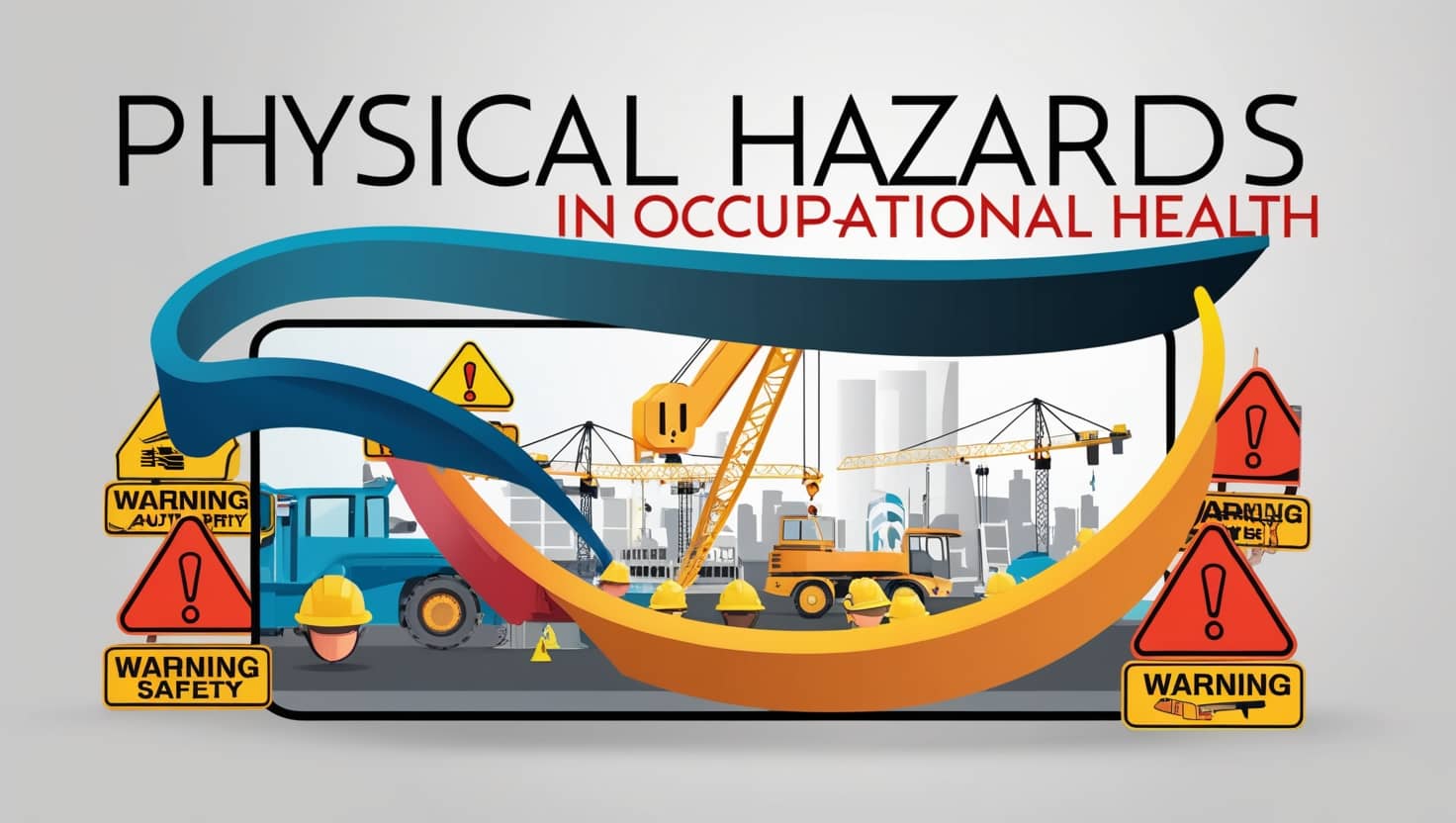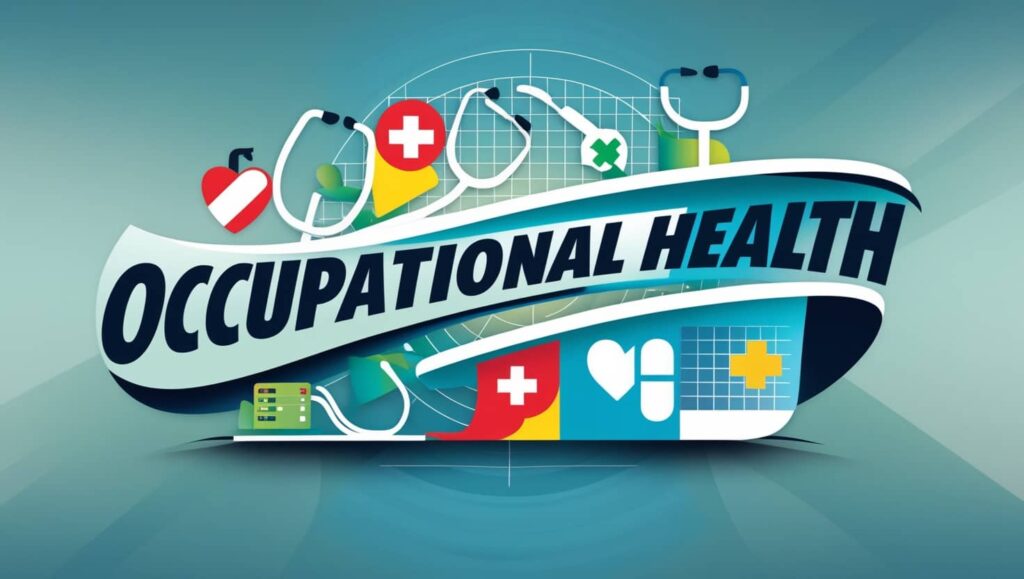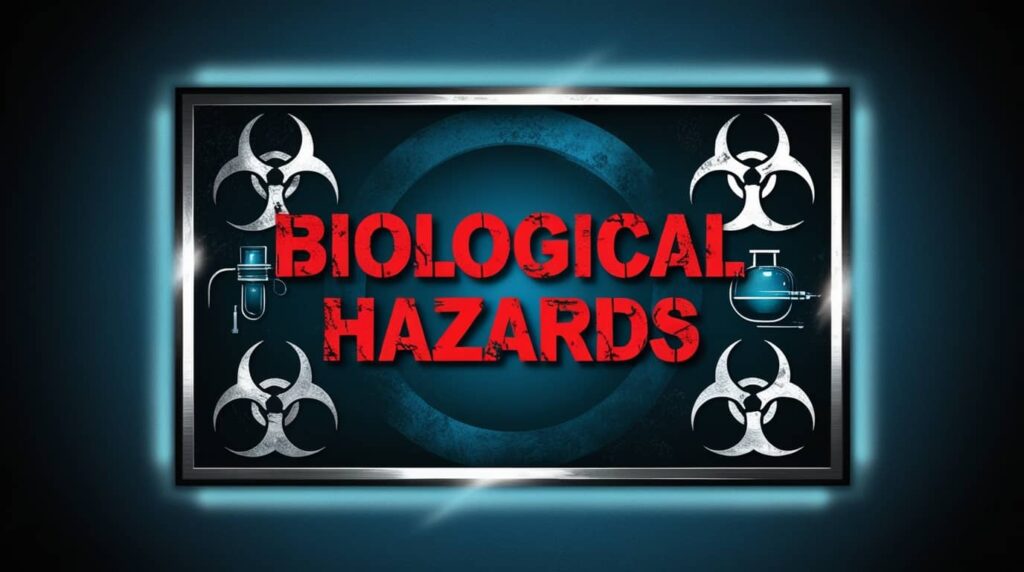Physical hazards are those that are caused by energy and matter and the interrelationships between the two.
In the workplace, they can be divided into worker-material interfaces, the physical work environment, and energy and electromagnetic radiation.
Physical hazards include biomechanical hazards, radiation, noise, extreme temperatures, pressurized systems, confined spaces, falling hazards, electrical hazards, etc.
The consequences of being exposed to these hazards can be reduced by worker protection and a variety of human factors.
Physical Hazards in Occupational Health
1. Ionizing Radiation
Ionizing radiation is defined as radiation with enough energy to dislodge electrons on impact from their otherwise stable orbitals clouds in an atom.
There are two types of ionizing radiation: electromagnetic radiation and particle radiation.
Radiation exposure can be “whole body” or limited to a specific body part.
Whole-body radiation might occur due to exposure to an unshielded source in an uncontrolled incident.
Radiation sickness is a syndrome caused by whole-body radiation exposure.
It may occur following external beam irradiation or radionuclide internal absorption.
Widespread cellular injury causes progressive multisystem disease, beginning with the tissues in which cell turnover is most rapid.
Radiation sickness is characterized first by loss of function in organs that require rapid cell turnover, including failure to produce blood cells or new hair and failure to repair skin and intestinal lesions. This is because radiation-induced genetic damage prevents cell replacement.
This causes immune system failure, resulting in infections, ulcers, hair loss, and blood loss from bleeding into the damaged gastrointestinal tract.
Radiation also affects the brain and can cause brain damage.
People can recover from moderate radiation exposure, but they are at risk for dementia, cancer (especially acute leukemia), cataracts, and infertility.
Limited or segmental radiation may come from an external source when a worker passes in front of the beam or if the shielding is faulty.
Limited or segmental external radiation, such as from a beam of particles or X-rays at high intensity, can cause tissue death, skin redness at the exposure site, and a variable risk of cancer with high exposure.
Specific effects of local irradiation may include: –
- Thyroid cancer with neck irradiation (relatively rare).
- Heavy irradiation to the head causes brain swelling and dementia.
- birth defects, especially neurological, from relatively low-level irradiation during pregnancy.
2. Electromagnetic Fields (EMF)
The effects of magnetic field exposure on health are currently unproven.
Even if it exists, the risk of cancer associated with EMF exposure does not appear to be great, and the available evidence is not convincing that it does.
3. Non-Ionizing Radiation
Non-ionizing radiation is composed of electromagnetic waves that radiate from a source at energies that are too low to ionize atoms in matter.
In contrast to ionizing radiation, no particles are involved (other than photons, the basic unit of electromagnetic energy).
The longer the wavelength, the higher the frequency and the less energy the wave carries.
- Ultraviolet light (for health purposes, 100–400 nm).
- Visible light (400–700 nm).
- Infrared (700 nm–300 μ m).
- Microwave (0.1 cm–10 m)
- Long radio frequency waves (> 10 m).
a. Ultraviolet Radiation
Ultraviolet radiation (UV) is a common and serious occupational physical hazard in outdoor work and certain occupations such as welding, where radiation is produced by open electrical arcs.
Exposure to UV is associated most characteristically with: –
- Sunburn in light-skinned people.
- Skin cancer.
- Eye problems, including cataracts.
“UV produced while welding can cause eye inflammation, which is known as “welder’s flash” and is quite painful, although it subsides after a few days.”
Control measures in the workplace include: –
- Using non-reflective paints on walls and other surfaces (containing titanium dioxide or zinc oxide).
- Hanging UV-impermeable plastic curtains between workstations.
- Separating activities such as welding into enclosed booths.
- Personal protection can be achieved by wearing protective work clothes and viewing the welding arc through helmets or hand shields with filter lenses.
b. Light in the Visible Spectrum
Almost all work requires illumination.
The adequacy of illumination is a limiting factor for accuracy and safety.
Coherent light is formed when the waves of light from a source are lined up and ordered in such a way that they form a narrow, high-energy beam.
Coherent light, in the form of laser beams, carries much more energy over a much longer distance than diffuse visible light.
Laser light can seriously harm the eyes and burn skin and other tissues. When focused by the lens on the retina.
A laser beam can cause serious injury and permanent destruction, leading to partial blindness.
Control measures
Safeguards should be present on all lasers that are not completely contained so that lasers cannot be inadvertently pointed toward someone.
Beam enclosures should be made out of fireproof, non-reflective materials.
Reflecting surfaces must be removed or covered because a reflected laser beam carries almost as much energy as the original beam.
Laser safety training is required whenever they are used.
c. Infrared
All objects produce infrared radiation in proportion to their temperature.
Heating occurs as a result of infrared radiation absorption.
The skin and eyes are the most heat-sensitive tissues in the human body.
The effects of infrared exposure include:
- Skin changes.
- Cataracts.
- Severe eye injury.
d. Microwave
Microwave refers to radiofrequency radiation on the spectrum that is above conventional radio and television transmission but below infrared.
Although they don’t seem to be common or important causes of workplace injuries, microwaves’ potential effects on human health are very controversial.
4. Noise
Noise is the most common and widespread occupational physical hazard.
It is a significant factor in the development of deafness, also known as noise-induced hearing loss.
Noise-induced hearing loss typically results in partial deafness, tends to occur later in life, and affects daily activities and communication.
It is preventable by avoiding excessive noise exposure.
Noise control is a highly technical specialty that may include acoustical engineering, plant design, engineering controls, and containment or isolation of noise sources.
However, the majority of issues involving excessive noise can be handled effectively and affordably using basic principles.
Many countries, including the United States and Canada, have occupational noise exposure standards that require employers to measure the noise level in the workplace if it is loud enough to interfere with easy speech communication or cause discomfort.
5. Pressure
Barometric pressure is the term used to describe atmospheric pressure levels.
Workplace conditions can expose employees to significantly higher or lower levels of pressure.
Work conditions in special environments include barometric pressures significantly above or below one atmosphere.
Barotraumas are the direct adverse effects of pressure changes and are of particular interest in aerospace and undersea medicine.
Hyperbaric pressure is a pressure that is higher than usual atmospheric pressure.
It is a particular problem in diving and caisson work, where air pressure is pumped up above one atmosphere to allow workers to work underwater.
Compression occurs when a diver descends underwater or a worker in a caisson is exposed to high pressure.
Compression-induced barotrauma problems arise when there is no free communication from an enclosed space to the outside to equilibrate pressure.
The increased external pressure pushes against a relatively negative pressure inside the enclosed space, resulting in ear trauma.
Decompression is a more common issue in diving.
Nitrogen and other gases in the blood that dissolved under pressure come back out again and form bubbles when a diver comes to the surface too quickly or when workers in compressed chambers, such as caissons, are depressurized too quickly.
Decompression sickness also referred to as “the bends,”. The bubbles may accumulate and block blood vessels, resulting in a stroke or spinal cord injury.
The treatment is re-pressurization, either by an immediate return to depth or in a hyperbaric chamber on the surface.
High Altitude: Rapid ascent to high altitude (7000–9000 m or more) without time to adjust can result in high altitude sickness, a condition that could be fatal.
This tends to be a problem among mountain climbers rather than workers.
Few industrial activities take place at elevations this high.
Related: Chemical Hazards in Occupational Health
6. Temperature Extremes
The human body closely regulates its own temperature to keep it close to an average of 37 ° C (as measured in the mouth).
Problems arise when temperature variations exceed the body’s ability to adapt or when adaptation mechanisms, such as sweating, are impaired.
Frostbite occurs when exposed body parts freeze, often the ears, nose, toes, and fingers.
Usually, it occurs because clothing does not adequately cover and insulate the face or hands or becomes wet from perspiration.
Heat stress is not limited to tropical climates or jobs that require working near a heat source.
It can also occur as a result of excessive heat retention caused by a combination of heavy clothing and strenuous exercise, or in heat and humidity combinations that interfere with evaporative cooling.
The most serious condition associated with heat stress is heat stroke.
Symptoms of heat stroke include headaches, dizziness, nausea, vomiting, and hyperthermia (core temperature frequently above 39 ° C).
The victim appears to be mentally confused and could be having a seizure.
Heat stroke is a medical emergency that needs to be treated right away in a hospital.
Heat fatigue is a temporary state of weakness, fatigue, and muscle cramps caused by salt depletion, often aggravated by dehydration.
Heat exhaustion, which is also caused by the depletion of salt, starts with dizziness, headache, weakness, fainting, cold and clammy skin, sweating, vomiting, blurred vision, and an upset stomach.
Both conditions respond quickly to rehydration, cooling, and rest.
Heat syncope is a loss of consciousness associated with a drop in blood pressure, which briefly reduces the supply to the brain.
The person feels dizzy and falls down but quickly recovers when the head is lower than the heart, restoring blood pressure to the brain.
Heat syncope occurs when a person stands for an extended period of time without moving because blood pools in the legs.
Prevention of heat stress
It can be prevented with shade, cooling, drinking a lot of fluids, a salt-rich diet (much better than salt tablets), and worker acclimatization.
In hot environments, clothing should not constrict any part of the body or obstruct airflow against the skin.
Also, intense exercise should only be performed for short periods of time; frequent rest breaks may be necessary.
7. Vibration
Whole-body vibration occurs when the entire body is shaken, especially at frequencies that shake the trunk disproportionately.
Segmental vibration affects a particular body part, usually the arm and hand when using handheld power tools, including chainsaws, pneumatic drills, riveting guns, grinders, chippers, air hammers, and cutting devices for concrete.
Vibration vasculitis, also known as “white finger disease,” is the most characteristic side effect of prolonged exposure to vibration at the hand.
Blood vessels constrict initially in response to the vibration and later in response to cold or spontaneously.
Read Also: Occupational Burnout | Background, Causes, and Symptoms
8. Other Physical Hazards
- Ergonomic hazards associated with patient care, such as services requiring repetitive motion, twisting, and lifting, as well as tasks, postures, and force levels required for some manipulations.
- Ergonomic hazards associated with workstation design or computer use.
- Ergonomic hazards associated with material handling of equipment, furniture, and supplies, such as lifting, carrying, pushing, pulling, and so on.
- Ergonomic hazards associated with driving include sustained postures (and potentially awkward posture) and duration.
- Falling hazards are associated with slips, trips and falls.
- Cuts are caused by sharp instruments, such as medical instruments and scissors, or equipment, such as needles, lancets, and so on.
- Electrical hazards associated with using electrical cords and appliances.
General Practices for Physical Hazards Control
a. Examples of Engineering Controls for Physical Hazards
- Substitution of a hazardous process with a less hazardous process.
- Process modification.
- Isolation.
- Use of material handling equipment (to replace manual handling).
- Guarding, shielding and barriers.
- Automated processes.
- Enclosures.
- Safety-engineered medical devices.
- Ergonomically designed equipment and facilities.
b. Examples of Administrative Controls for Physical Hazards
- Policies and procedures.
- Orientation and training.
- Purchasing standards and procedures.
- Work scheduling.
- Job rotation.
- Exposure monitoring specific to the hazard (e.g., noise, radiation, etc.).
- Health assessments appropriate to the hazard (e.g., audiometric tests for noise exposure).
- Warning signs.
- Maintenance and cleaning programs.
- Separate lunchroom and break facilities.
c. Examples of Personal Protective Equipment for Physical Hazards
- Gloves.
- Eye protection.
- Protective clothing.
- Head protection (e.g., hard hats).
- Footwear.
- Hearing protection.
- Respiratory protection.
- Lead aprons (radiation).
Summary
Physical hazards are those that are caused by energy and matter and the interrelationships between the two.
In the workplace, they can be divided into worker-material interfaces, the physical work environment, and energy and electromagnetic radiation.
Physical hazards include biomechanical hazards, radiation, noise, extreme temperatures, pressurized systems, confined spaces, falling hazards, electrical hazards, etc.
The consequences of being exposed to these hazards can be reduced by worker protection and a variety of human factors.
Physical Hazards in Occupational Health include: –
- Ionizing Radiation
- Non-Ionizing Radiation
-
- Ultraviolet Radiation
- Light in the Visible Spectrum
- Infrared
- Noise
- Pressure
- Temperature Extremes
- Vibration
- Ergonomic hazards
Engineering Controls for physical hazards include a substitution of a hazardous process with a less hazardous process, isolation, guarding, shielding and barriers.
Administrative controls for physical hazards include policies and procedures, orientation and training, purchasing standards and procedures, work schedules, and job rotation.
Personal protective equipment for physical hazards includes gloves, eye protection, protective clothing, head protection (e.g., hard hats), and footwear.
References
Guidotti, T. L. (2011). Global occupational health. Oxford University Press.
Introduction to physical hazards. Retrieved December 20, 2022, from ResearchGate
Govt. of Alberta. (2011). Best practices for the assessment and control of physical hazards: Best practices guidelines for occupational health and safety in the healthcare industry.
College and association of acupuncturists of Alberta. (2014). Handbook of Occupational Hazards and Controls.
Yusuf Saeed
Pharmacist | Medical Writer & Translator
Yusuf Saeed graduated from the Arab Academy for Science and Technology and Maritime Transport with a B.Sc. in Pharmaceutical Sciences. His passion for research and healthcare communication led him to specialize in medical writing and translation. Yusuf is committed to delivering accurate, well-researched content that empowers readers with reliable medical information and bridges language gaps in healthcare education.
As the founder of Medserene, Yusuf Saeed established the platform with a vision to provide trustworthy medical content and accessible healthcare information. His mission is to create a reliable resource that empowers readers to make informed decisions about their health and well-being. Driven by his passion for clear communication and healthcare education, Yusuf aims to bridge the gap between medical knowledge and everyday understanding.







